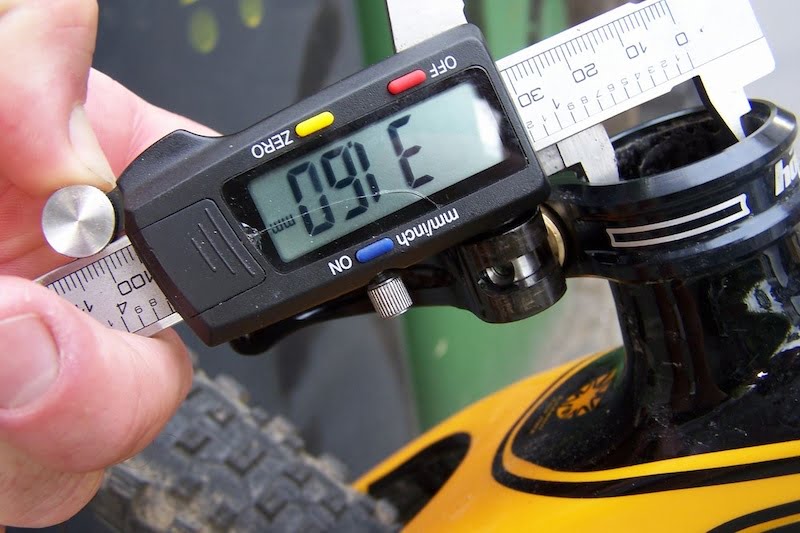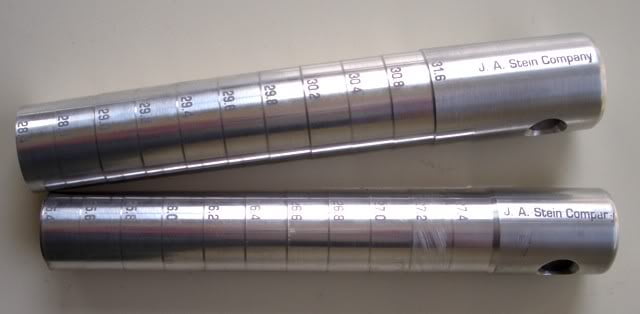To help prevent mistakes when purchasing or changing seatposts, this article explains what kinds of seatpost diameters are most commonly used and how they are measured. Only diameter (width) is dealt with here. The length of the seatpost depends on frame geometry (design) and size – i.e. how much the saddle needs to be raised from the end of the seat tube. A separate article explains the maximum amount of seatpost extension from the frame (minimal insertion length). For seatpost height in terms of bicycle fitting, see: Setting up comfortable riding position.
Table Of Contents (T.O.C.):
TL/DR
If your seatpost is too wide, it won’t fit in the frame (and will get badly stuck if you force it). If it’s too narrow, it will slip (and your frame might crack when you tighten it).
Here, I’ve explained:
- How to measure your frame and your seatpost?
- Which size standards exist?
The latter is important because if you measure 27.18 mm, for example, it’s good to know that it’s most probably the 27.2 mm standard (as the other standards are 0.2 mm apart: 27.0, and 27.4 mm).
0. Terms
It is important to understand two terms:
- “seat tube” – the tube in the frame that holds the seatpost.
- “seatpost” – the post the saddle is mounted on.
Picture 1 shows a seatpost (1), and a seat tube (2):


Pictures 1a, and 1b
1. A bit of history
The first bicycle frames were made mostly from steel, with steel tubes of a standard (outer) diameter. The British and Italian standard diameter for seat tubes was 1 1/8″ (28.6 mm). Older French bicycles used 28 mm tubing. Old US bicycles (mostly BMX and older bikes that used one-piece cranks) was 1″ (25.4 mm).
Standard outer diameter dimensions were important so that derailleur clamps etc. could be made in exact matching sizes (derailleur clamp inner diameter needs to match the seat tube’s outer diameter). Higher quality frames are usually made with thinned down tube walls to reduce the weight of the frame. This meant that a wider seatpost diameter usually meant a higher quality (and lighter) frame. So high-quality frames with 1 1/8″ seat tubes usually had 27.2 mm wide seatposts.
A more modern trend, mostly on mountain bikes, where stronger seatposts are required (without too much extra weight) led to a new “oversized” standard of 27.4 mm (and wider).
2. Measuring required seatpost diameter
“One (precise) measurement is often better than a thousand expert opinions” – author’s expert opinion. 🙂
How to measure the seatpost diameter? The easiest and most accurate method is to use calipers (Vernier, or digital), as shown in picture 2.

Source: forums.mtbr.com
Picture 2
It can be seen from picture 2 that the seatpost is marked as 31.6 mm wide (and 410 mm long), while it really measures only 31.42 mm. This means the seatpost will probably not fit firmly enough to stay in place inside a seat tube meant for 31.6 mm wide seatposts. Always measure! 🙂
Measuring a seat tube diameter is often necessary before purchasing, or changing the seatpost. How should one do that? Three methods will be explained here, but one can always be creative. 🙂
Method 1: if the frame already has a mounted matching seatpost – one that attaches firmly enough so it doesn’t slide, while being narrow enough to allow easy mounting and dismounting – then it is sufficient to measure its outer diameter, as was explained above in the section – “How to measure the seatpost diameter?”.
Method 2: using calipers, as shown in picture 3.

Source: forums.mtbr.com
Picture 3
Method 3: using special seat post sizing rods. These are rods with an increasing diameter from one end to the other, with a scale noting the diameter in standard sizes. The rod is simply placed in the seat tube and the matching diameter is the one just above the end of the seat tube (the first visible number on the rod still sticking out of the tube). Place a screwdriver through a hole at the top of the rod, just to make sure it doesn’t drop all the way in if the sizing rod is too small. 🙂

Source: bikeforums.net
Picture 4
Since measuring often can’t be done to a 1/100 of a millimeter in accuracy, the next section gives a list of the most commonly used standard seatpost diameters. If a measured diameter differs, it can be assumed that the correct diameter is the standard one that most closely matches the measured diameter.
3. Standard seatpost diameters
Table 1 gives a list (in mm) of standard diameter sizes:

Table 1
Seatpost diameters are usually a multiple of 0.2 mm (but not always, as tables 1 and 2 show). If a measured value differs and most closely matches a value that is not a multiple of 0.2, there is a high probability that the closest multiple of 0.2 mm size will fit. For example, a measured 25.5 will most probably fit a 25.4 mm wide (nominal and measured width) seatpost. A rule of thumb is that the widest post that slides in without being forced (other than pushing or twisting by hand) is the right one. If it drops in, with play, before the pinch bolt is tightened, the seatpost is probably too narrow.
A few notes, just in case:
- If a seatpost wobbles or rocks left-right (before tightening the clamp), it is probably too narrow.
- Don’t punch it in. If it can’t be eased in by hand, it’s probably too wide. Forcing it in makes it very, very difficult to move or take out later. It might even damage some frames.
For easier managing, table 2 gives an overview of seatpost diameters most commonly used on modern bicycles (from the end of the 20th century to now).

Table 2
Help BikeGremlin
stay online & independent
This website is educational, free, objective, and not commercial
(sponsors don’t enjoy paying if you mention all the product downsides that you notice 🙂 ).
How much does a WordPress website cost?
If you find this site to be good and helpful,
and if $5 per month is what you can afford to set aside,
please consider supporting my work with a Patreon donation:

The existing comments posted under this article (questions and answers) have been moved to this BikeGremlin forum thread:
https://www.bikegremlin.net/threads/seatpost-diameter-sizes-standards-article-comments.120/

Is it possible to sand down a 25.8mm aluminum seatpost to 25.4mm?
Hi Bob,
I would rather not risk making the seatpost walls thinner (and thus weaker).
But it is possible.
Relja
Hi, My bike frame seat post is 30.9mm in diameter, what size dropper post do I need for it to seamlessly fit in the seat tube?
I have a Merida Big 9 15 by the way
Hi Drona,
If the current seatpost is a well-fitting one, and it is 30.9 mm, I’d look for a 30.9 mm dropper seatpost.
Seamless sliding is not always possible – but it shouldn’t fit too loosely (you shouldn’t be able to rock it left-right when it’s inserted), nor take too much force to slide it in (no punching, or using full strength to get it in – that means it’s too wide).
Relja
Hi Relja,
Sorry, I meant that my seat tube is 30.9mm. What seat post would best fit in that seat tube, I was thinking 27.2 but wouldn’t that be too narrow?
Also I am having trouble looking for 27.2mm dropper posts with at least 100mm travel under $170 AUD.
Do you know any dropper post which suits what I mentioned above?
Hi Drona,
The seatpost depends on the inner seat tube diameter. The outer diameter does not reliably tell us the exact inner diameter (that depends on the wall thickness).
The safest way to determine this is to measure (I like to say that one good measurement is better than a thousand expert opinions 🙂 ).
It is easiest to measure the existing seatpost outer diameter – if there is a well-fitting seatpost on the bike. In case there’s no seatpost, we would need to measure the seat-tube’s inner diameter (using calipers, and minding to measure the tube itself, not the seat-clamp’s inner diameter).
From what I can Google, Merida Big Nine 15 has a 27.2 mm seatpost (Merida website link). Still, I would rather measure before buying anything – just to be on the safe side.
As for the dropper seatpost recommendations, I would ask on bikeforums.net MTB section (link to bikeforums website). There are many experienced cyclists and mechanics on that forum. I’m not an expert on dropper seatpost models. With a note that it’s a good idea to state one’s country, since otherwise many shopping advice are, how to put it… “US-centric.” 🙂
Relja
alot of bikes are made with missmatched seatpost and you will also find some bikes that have a build up of paint around the seatpost hole,on most older steel bikes you can remove that old paint build up with a smooth round file and chase up the correct size seatpost,even some weld splatter stops seat post from fitting correctly,very common on older bikes,you seatpost should fit in without too much force and should not be floppy when you slide it down,you can buy seat post in just about every size,the older 25.4mm ones can still be found on new steel bikes,discarded old bikes are a very good place to look for hard to find seatposts.
Hi
I want to purchase a Pinarello f10 seatpost, I have seen one on eBay which states
23mm x 60mm cross section length 350mm, would this hit my f10.
I am sceptical about things on eBay the only reason I looked was because of price as a new one is £300. The ad states genuine Pinarello seatpost but the price is £130 so you can understand my reluctance.
Many thanks
Gary
Hi Gary,
I’m not sure. It’s worth measuring the inner dimensions of your seat-tube just to make sure (callipers are a good tool for that).
It’s even easier to measure a fitting seatpost if you have one.
As far as I know, 150-sh pounds is what these go for 2nd hand/used (ebay and the likes) – but take my info with a grain of salt.
Relja
not a mention here of size 26.0 post on my old TREK antelope. That is the number stamped on the current post and it fits snug but slides nice so it must be correct. And the caliper confirms too. I am trying to find a seat thudbuster for that size. May be impossible as it looks to be a very rare size seatpost. suggestions? thanks, Brian maybe I should get a newer bike!!!!! It’s an antique.
Hi Brian,
Yes, 26 mm is not the most commonly used size (though it is listed in Table 1 above), but I could find it online.
Here’s one example (Amazon affiliate link).
Here’s a zero setback one from bike24.com.
Another one, with setback, from bike24.com